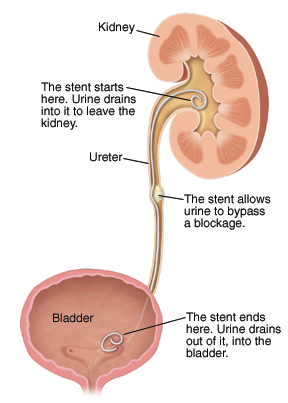A ureteral stent is a soft plastic tube with holes in it. It’s temporarily inserted into a ureter to help drain urine into the bladder. One end goes in the kidney. The other end goes in the bladder. A coil on each end holds the stent in place. The stent can’t be seen from outside the body. It shouldn’t interfere with your normal routine. Your stent will be put in by a urologist (doctor trained in treating the urinary tract) or another specialist. The procedure is done in a hospital or surgery center. You’ll likely go home the same day.
When Is a Ureteral Stent Used?
A ureteral stent may be used:
- To bypass a blockage in a kidney or ureter.
- During kidney stone removal.
- To let a ureter heal after surgery.
Before the Procedure
Your doctor will give you instructions to prepare for the procedure. X-rays or other imaging tests of your kidneys and ureters may be done beforehand.
During the Procedure
- You receive medication to prevent pain and help you relax or sleep during the procedure. Once this takes effect, the procedure starts.
- The doctor inserts a cystoscope (lighted instrument) through the urethra and into the bladder. This shows the opening to the ureter.
- A thin wire is carefully threaded through the cystoscope, up the ureter, and into the kidney. The stent is inserted over the wire.
- A fluoroscope (special x-ray machine) is used to help position the stent. When the stent is in place, the wire and cystoscope are removed.
While You Have a Stent
- Some discomfort is normal. Certain movements may trigger pain or a feeling that you need to urinate. You may also feel mild soreness or pressure before or during urination. These symptoms will go away a few days after the stent is removed.
- Medication to control pain or bladder spasms or to prevent infection may be prescribed. Take this as directed.
- Drink plenty of fluids to help flush out your urinary tract.
- Your urine may be slightly pink or red. This is due to bleeding caused by minor irritation from the stent. This may happen on and off while you have the stent.
How Long Will You Need a Stent?
The stent is often taken out after the blockage in the ureter is treated or the ureter has healed. This may take 1–2 weeks, or longer. If a stent is needed for a long time, it may need to be changed every few months.
Call Your Doctor If:
|
